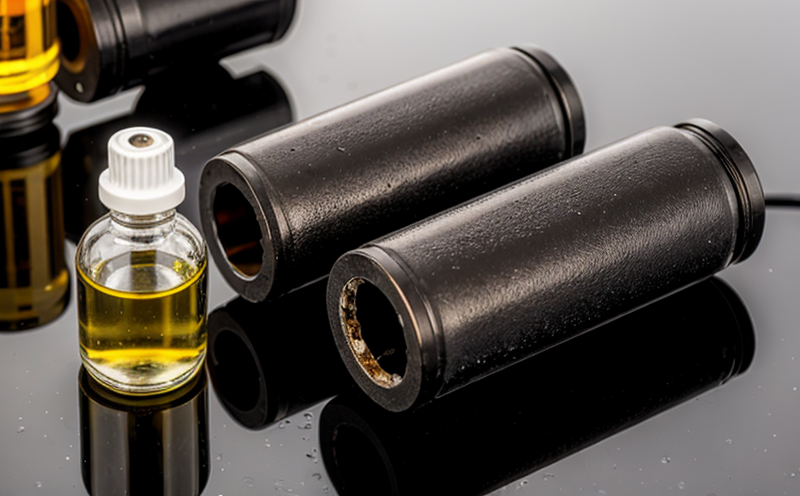EPA 8015 Nonhalogenated Organics Hydrocarbons Test in Water
The EPA 8015 method is a critical tool for determining the presence of non-halogenated organic hydrocarbons (e.g., alkanes, cycloalkanes, and aromatics) in water samples. This test is particularly important in environmental monitoring and compliance activities, especially in sectors such as wastewater treatment facilities, oil and gas operations, and chemical manufacturing.
The primary objective of this method is to measure the concentration of hydrocarbons that are not substituted with halogen atoms (such as chlorine or bromine). These compounds can be indicative of contamination from various sources including petroleum spills, industrial discharges, and accidental releases. Understanding these contaminants is essential for ensuring water quality meets regulatory standards.
The EPA 8015 method involves several key steps: sample collection, extraction, cleanup, and analysis using gas chromatography with a flame ionization detector (GC-FID). The extract obtained from the sample undergoes thorough cleanup to remove matrix interferences before being analyzed by GC-FID. This sophisticated approach allows for accurate quantification of hydrocarbons present in water samples.
The method is described in detail in the EPA's official document, which specifies the procedural steps and quality control measures necessary to ensure reliable results. Compliance with these guidelines ensures that laboratories can provide robust data for regulatory bodies and other stakeholders who depend on accurate measurements of hydrocarbon levels.
One critical aspect of this test is its ability to differentiate between various types of hydrocarbons, which allows for targeted remediation efforts if contamination is detected. For instance, the presence of specific compounds like benzene or toluene can indicate petroleum-based pollutants, while others might suggest industrial solvents.
In summary, the EPA 8015 method plays a vital role in environmental monitoring by providing precise quantitative analysis of non-halogenated organic hydrocarbons. Its application is widespread across industries dealing with water quality and pollution control. By adhering to this rigorous testing protocol, laboratories ensure that they deliver accurate and reliable data supporting regulatory compliance.
Quality and Reliability Assurance
Ensuring the highest standards of accuracy and reliability in EPA 8015 testing is paramount for maintaining trust within both regulatory bodies and industry partners. Our laboratory employs a robust quality management system that encompasses comprehensive training programs, rigorous calibration protocols, and stringent validation processes.
- Training Programs: All staff undergo extensive training to ensure they are proficient in handling complex samples and operating advanced instruments like GC-FID systems.
- Calibration Protocols: Regular calibration of all equipment ensures that the measurements remain precise and consistent over time. This includes periodic checks with known standards to validate analytical performance.
- Validation Processes: New methods are validated before implementation, ensuring they meet or exceed regulatory requirements. Continuous validation ensures ongoing compliance and accuracy.
We also maintain strict adherence to international standards such as ISO 17025 for laboratory accreditation, which further enhances our reputation for delivering high-quality results. By upholding these stringent practices, we guarantee that every EPA 8015 test conducted is reliable and can be trusted.
Customer Impact and Satisfaction
- Enhanced Compliance: By providing accurate hydrocarbon testing results, our customers can ensure they are meeting all relevant regulatory requirements. This is crucial for maintaining a positive reputation within their respective industries.
- Improved Decision-Making: Reliable data from EPA 8015 tests allows businesses to make informed decisions regarding potential contamination issues and appropriate remediation strategies.
- Increased Efficiency: Our efficient testing processes help reduce downtime for facilities, enabling quicker resolution of any identified problems. This is particularly beneficial in critical sectors like water treatment plants where continuous operation is essential.
In addition to these tangible benefits, customer satisfaction is further enhanced by our commitment to exceptional service. We offer prompt turnaround times and transparent communication throughout the testing process, ensuring that all inquiries are addressed promptly and comprehensively.
International Acceptance and Recognition
The EPA 8015 method enjoys widespread acceptance across numerous countries worldwide due to its rigorous standards and reliability. Many international bodies, including the United Nations Environment Programme (UNEP) and various national environmental protection agencies, recognize this test as a standard practice for assessing hydrocarbon content in water.
Compliance with EPA 8015 is not only necessary but also advantageous when engaging in global projects or partnering with international organizations. This recognition ensures that the results generated by our laboratory are universally accepted and can be used interchangeably across borders.
The method's broad acceptance highlights its importance in promoting environmental stewardship globally. As part of this initiative, we strive to contribute positively towards sustainable practices by providing accurate and reliable hydrocarbon testing services.





